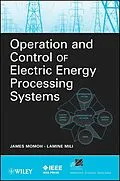The purpose of this book is to provide a working knowledge and an exposure to cutting edge developments in operation and control of electric energy processing systems. The book focuses on the modeling and control of interdependent communications and electric energy systems, Micro-Electro-Mechanical Systems (MEMS), and the interdisciplinary education component of the EPNES initiative.
Autorentext
James Momoh was chair of the Electrical Engineering Department at Howard University and director of the Center for Energy Systems and Control. In 1987, Momoh received a National Science Foundation (NSF) Presidential Young Investigator Award. He is a Fellow of the IEEE and a Distinguished Fellow of the Nigerian Society of Engineers (NSE). His current research activities for utility firms and government agencies span several areas in systems engineering, optimization, and energy systems' control of complex and dynamic networks.
Lamine Mili is Professor of Electrical and Computer Engineering at Virginia Tech. An IEEE Senior Member, Dr. Mili is also a member of Institute of Mathematical Statistics and the American Statistical Association. His research interests include risk assessment and management of critical infrastructures; power system analysis and control; bifurcation theory and chaos; and robust statistics as applied to engineering problems.
Klappentext
Explains the fundamental issues related to control, communications, and social aspects of large-scale electric energy processing systems
Focusing on the dynamic modeling and control of interdependent communications and electric energy systems, micro-electro-mechanical systems (MEMS), and the interdisciplinary education component of the EPNES (Electric Power Networks Efficiency and Security) initiative, Operation and Control of Electric Energy Processing Systems provides a working knowledge of, as well as cutting-edge developments in, electric power systems theory and applications.
The book begins with an introduction to the EPNES initiative, and then investigates several dynamical models in fault tolerant operation and control of energy processing systems. Intelligent power routers for distributed coordination of electric energy processing networks are developed. Next, the book addresses the design of power circuit breakers, using an array of small MEMS switches together with diodes for faster operation and smaller equipment size aimed at reducing the vulnerability of a power system to faults.
A GIS-based market simulation studies for power systems education is then developed. Finally, the book employs a social-sciences approach to help understand the development and use of distributed generation technologiessmall-scale generators that produce power near their loadsin the electric power system.
Operation and Control of Electric Energy Processing Systems can be used both as a book for teaching graduate courses and as a handbook that provides state-of-the-art knowledge to engineers and researchers working worldwide in interdisciplinary areas such as control, power systems, economics, environment, and social sciences. It will also appeal to policy makers as well as executives and engineers of electric utilities.
Inhalt
Preface ix
Contributors xi
1 A FRAMEWORK FOR INTERDISCIPLINARY RESEARCH AND EDUCATION 1
James Momoh
1.1 Introduction 1
1.2 Power System Challenges 4
1.2.1 The Power System Modeling and Computational Challenge 5
1.2.2 Modeling and Computational Techniques 6
1.2.3 New Interdisciplinary Curriculum for the Electric Power Network 6
1.3 Solution of the EPNES Architecture 6
1.3.1 Modular Description of the EPNES Architecture 6
1.3.2 Some Expectations of Studies Using EPNES Benchmark Test Beds 7
1.4 Test Beds for EPNES 8
1.4.1 Power System Model for the Navy 8
1.4.2 Civil Test Bed179-Bus WSCC Benchmark Power System 10
1.5 Examples of Funded Research Work in Response to the EPNES Solicitation 10
1.5.1 Funded Research by Topical Areas/Groups under the EPNES Award 10
1.5.2 EPNES Award Distribution 12
1.6 Future Directions of EPNES 13
1.7 Conclusions 14
2 DYNAMICAL MODELS IN FAULT-TOLERANT OPERATION AND CONTROL OF ENERGY PROCESSING SYSTEMS 15
Christoforos N. Hadjicostis, Hugo Rodr´guez Cort´es, Aleksandar M. Stankovic
2.1 Introduction 15
2.2 Model-Based Fault Detection 16
2.2.1 Fault Detection via Analytic Redundancy 17
2.2.2 Failure Detection Filters 17
2.3 Detuning Detection and Accommodation on IFOC-Driven Induction Motors 19
2.3.1 Detuned Operation of Current-Fed Indirect Field-Oriented Controlled Induction Motors 20
2.3.2 Detection of the Detuned Operation 24
2.3.3 Estimation of the Magnetizing Flux 26
2.3.4 Accommodation of the Detuning Operation 27
2.3.5 Simulations 28
2.4 Broken Rotor Bar Detection on IFOC-Driven Induction Motors 28
2.4.1 Squirrel Cage Induction Motor Model with Broken Rotor Bars 29
2.4.2 Broken Rotor Bar Detection 31
2.5 Fault Detection on Power Systems 35
2.5.1 The Model 35
2.5.2 Class of Events 37
2.5.3 The Navy Electric Ship Example 38
2.5.4 Fault Detection Scheme 39
2.5.5 Numerical Simulations 41
2.6 Conclusions 43
3 INTELLIGENT POWER ROUTERS: DISTRIBUTED COORDINATION FOR ELECTRIC ENERGY PROCESSING NETWORKS 47
Agust´n A. Irizarry-Rivera, Manuel Rodr´guez-Mart´nez, Bienvenido V´elez, Miguel V´elez-Reyes, Alberto R. Ramirez-Orquin, Efra´n O'Neill-Carrillo, Jos´e R. Cedeno
3.1 Introduction 47
3.2 Overview of the Intelligent Power Router Concept 48
3.3 IPR Architecture and Software Module 50
3.4 IPR Communication Protocols 55
3.4.1 State of the Art 55
3.4.2 Restoration of Electrical Energy Networks with IPRs 59
3.4.3 Mathematical Formulation 60
3.4.4 IPR Network Architecture 60
3.4.5 Islanding-Zone Approach via IPR 61
3.4.6 Negotiation in Two Phases 62
3.4.7 Experimental Results 65
3.5 Risk Assessment of a System Operating with IPR 65
3.5.1 IPR Components 65
3.5.2 Configuration 66
3.5.3 Example 66
3.6 Distributed Control Models 71
3.6.1 Distributed Control of Electronic Power Distribution Systems 71
3.6.2 Integrated Power System in Ship Architecture 74
3.6.3 DC Zonal Electric Distribution System 76
3.6.4 Implementation of the Reconfiguration Logic 77
3.6.5 Conclusion 77
3.7 Reconfiguration 79
3.8 Economics Issues of the Intelligent Power Router Service 79
3.8.1 The Standard Market Design (SMD) Environment 80
3.8.2 The Ancillary Service (A/S) Context 81
3.8.3 Reliability Aspects of Ancillary Services 81
3.8.4 The IPR Technical/Social/Economical Potential for Optimality 81
3.8.5 Proposed Definition for the Intelligent Power Router Ancillary Service 82
3.8.6 Summary 82
3.9 Conclusions 82
4 POWER CIRCUIT BREAKER USING MICROMECHANICAL SWITCHES 87
George G. Karady, Gerald T. ...
